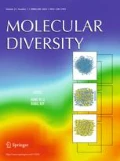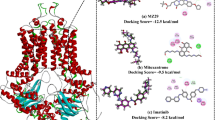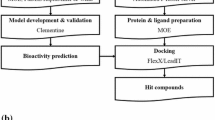Abstract
The overexpression of ABCC2/MRP2, an ATP-binding cassette transporter, contributes to multidrug resistance in cancer cells. In this study, a quantitative structure–activity relationship (QSAR) analysis on ABCC2 inhibitors has been carried out, aiming to establish a computational prediction model for ABCC2 modulators. Seven classification models and two regression models were built by SONNIA 4.2, and two other regression models were built by MOE 2008.10 based on a data set comprising 372 compounds collected from 16 relevant publications. The CPG-C iABCC2 model for classifying ABCC2 inhibitors has total accuracy of 0.88 and Matthews correlation coefficient MCC = 0.75. The CPG-C iEG model for classifying ABCC2 inhibitors (substrate EG: β-estradiol 17-β-d-glucuronide) has total accuracy of 0.91 and MCC = 0.82. The regression model PLS EG-IC50 for predicting ABCC2 inhibitors (substrate EG) gave root-mean-square error RMSE = 0.26, Q2 = 0.73 and \( R_{\text{pred}}^{2} = 0.63 \). The regression model PLS CDCF-IC50 for predicting ABCC2 inhibitors [substrate CDCF: 5(6)-carboxy-2′,7′-dichlorofluorescein] gave RMSE = 0.31, Q2 = 0.74 and \( R_{\text{pred}}^{2} = 0.67 \). Four 2D-QSAR models were applied to 1661 compounds, with results indicating 369 compounds having the ability to reverse the efflux of both EG and CDCF by ABCC2, 152 among them having IC50 < 100 µM.
Graphic abstract






Similar content being viewed by others
References
Jedlitschky G, Hoffmann U, Kroemer HK (2006) Structure and function of the MRP2 (ABCC2) protein and its role in drug disposition. Expert Opin Drug Metab Toxicol 2:351–366. https://doi.org/10.1517/17425255.2.3.351
Wissel G, Kudryavtsev P, Ghemtio L, Tammela P, Wipf P, Yliperttula M, Finel M, Urtti A, Kidron H, Xhaard H (2015) Exploring the structure–activity relationships of ABCC2 modulators using a screening approach. Biorg Med Chem 23:3513–3525. https://doi.org/10.1016/j.bmc.2015.04.029
Xing L, Hu Y, Lai Y (2009) Advancement of structure-activity relationship of multidrug resistance-associated protein 2 interactions. AAPS J 11:406–413. https://doi.org/10.1208/s12248-009-9117-0
Zhang H, Xiang ML, Zhao YL, Wei YQ, Yang SY (2009) Support vector machine and pharmacophore-based prediction models of multidrug-resistance protein 2 (MRP2) inhibitors. Eur J Pharm Sci 36:451–457. https://doi.org/10.1016/j.ejps.2008.11.014
Hillgren KM, Keppler D, Zur A, Giacomini KM, Stieger B, Cass C, Zhang L (2013) Emerging transporters of clinical importance: an update from the International Transporter Consortium. Clin Pharmacol Ther 94:52–63. https://doi.org/10.1038/clpt.2013.74
El-Sheikh AA, van den Heuvel JJ, Koenderink JB, Russel FG (2007) Interaction of nonsteroidal anti-inflammatory drugs with multidrug resistance protein (MRP) 2/ABCC2- and MRP4/ABCC4-mediated methotrexate transport. J Pharmacol Exp Ther 320:229–235. https://doi.org/10.1124/jpet.106.110379
Förster F, Volz A, Fricker G (2008) Compound profiling for ABCC2 (MRP2) using a fluorescent microplate assay system. Eur J Pharm Biopharm 69:396–403. https://doi.org/10.1016/j.ejpb.2007.10.003
Han YH, Kato Y, Haramura M, Ohta M, Matsuoka H, Sugiyama Y (2001) Physicochemical parameters responsible for the affinity of methotrexate analogs for rat canalicular multispecific organic anion transporter (cMOAT/MRP2). Pharm Res 18:579–586. https://doi.org/10.1023/A:1011064806507
Heredi-Szabo K, Kis E, Molnar E, Gyorfi A, Krajcsi P (2008) Characterization of 5(6)-carboxy-2′,7′-dichlorofluorescein transport by MRP2 and utilization of this substrate as a fluorescent surrogate for LTC4. J Biomol Screen 13:295–301. https://doi.org/10.1177/1087057108316702
Jedlitschky G, Leier I, Buchholz U, Hummel-Eisenbeiss J, Burchell B, Keppler D (1997) ATP-dependent transport of bilirubin glucuronides by the multidrug resistance protein MRP1 and its hepatocyte canalicular isoform MRP2. Biochem J 327:305–310. https://doi.org/10.1042/bj3270305
Kidron H, Wissel G, Manevski N, Häkli M, Ketola RA, Finel M, Yliperttula M, Xhaard H, Urtti A (2012) Impact of probe compound in MRP2 vesicular transport assays. Eur J Pharm Sci 46:100–105. https://doi.org/10.1016/j.ejps.2012.02.016
Leyers S, Häcker HG, Wiendlocha J, Gütschow M, Wiese M (2008) A 4-aminobenzoic acid derivative as novel lead for selective inhibitors of multidrug resistance-associated proteins. Bioorg Med Chem Lett 18:4761–4763. https://doi.org/10.1016/j.bmcl.2008.07.127
Pedersen JM, Matsson P, Bergström CA, Norinder U, Hoogstraate J, Artursson P (2008) Prediction and identification of drug interactions with the human ATP-binding cassette transporter multidrug-resistance associated protein 2 (MRP2; ABCC2). J Med Chem 51:3275–3287. https://doi.org/10.1021/jm7015683
Procko E, O’Mara ML, Bennett WD, Tieleman DP, Gaudet R (2009) The mechanism of ABC transporters: general lessons from structural and functional studies of an antigenic peptide transporter. FASEB J 23:1287–1302. https://doi.org/10.1096/fj.08-121855
Slot AJ, Wise DD, Deeley RG, Monks TJ, Cole SP (2008) Modulation of human multidrug resistance protein (MRP) 1 (ABCC1) and MRP2 (ABCC2) transport activities by endogenous and exogenous glutathione-conjugated catechol metabolites. Drug Metab Dispos 36:552–560. https://doi.org/10.1124/dmd.107.019661
Vadlapatla RK, Vadlapudi AD, Kwatra D, Pal D, Mitra AK (2011) Differential effect of P-gp and MRP2 on cellular translocation of gemifloxacin. Int J Pharm 420:26–33. https://doi.org/10.1016/j.ijpharm.2011.08.009
van Zanden JJ, Wortelboer HM, Bijlsma S, Punt A, Usta M, van Bladeren PJ, Rietjens IM, Cnubben NH (2005) Quantitative structure activity relationship studies on the flavonoid mediated inhibition of multidrug resistance proteins 1 and 2. Biochem Pharmacol 69:699–708. https://doi.org/10.1016/j.bcp.2004.11.002
Wortelboer HM, Usta M, van der Velde AE, Boersma MG, Spenkelink B, van Zanden JJ, Rietjens IM, van Bladeren PJ, Cnubben NH (2003) Interplay between MRP inhibition and metabolism of MRP inhibitors: the case of curcumin. Chem Res Toxicol 16:1642–1651. https://doi.org/10.1021/tx034101x
Hirono S, Nakagome I, Imai R, Maeda K, Kusuhara H, Sugiyama Y (2005) Estimation of the three-dimensional pharmacophore of ligands for rat multidrug-resistance-associated protein 2 using ligand-based drug design techniques. Pharm Res 22:260–269. https://doi.org/10.1007/s01869-005-1869-8
Herédi-Szabó K, Kis E, Krajcsi P (2012) The vesicular transport assay: validated in vitro methods to study drug-mediated inhibition of canalicular efflux transporters ABCB11/BSEP and ABCC2/MRP2. Curr Protoc Toxicol 54:23.4.1–23.4.16. https://doi.org/10.1002/0471140856.tx2304s54
Lai Y, Xing L, Poda GI, Hu Y (2007) Structure–activity relationships for interaction with multidrug resistance protein 2 (ABCC2/MRP2): the role of torsion angle for a series of biphenyl-substituted heterocycles. Drug Metab Dispos 35:937–945. https://doi.org/10.1124/dmd.106.013250
RapidMiner 5. http://www.rapidminer.com. Accessed 27 May 2019
Weka 36. http://www.cswaikatoacnz/~ml/weka/. Accessed 27 May 2019
Molecular Operating Environment (MOE) 2008.10. http://www.chemcomp.com. Accessed 30 May 2019
Cramer RD (1993) Partial least squares (PLS): its strengths and limitations. Perspect Drug Discov Des 1:269–278. https://doi.org/10.1007/BF02174528
Ajith A (2005) Artificial neural networks handbook of measuring system design. Wiley, Hoboken
Terfloth L, Gasteiger J (2001) Neural networks and genetic algorithms in drug design. Drug Discov Today 6:102–108. https://doi.org/10.1016/S1359-6446(01)00173-8
Hecht-Nielsen R (1987) Counterpropagation networks. Appl Opt 26:4979–4984. https://doi.org/10.1364/AO.26.004979
Roy K, Kar S, Ambure P (2015) On a simple approach for determining applicability domain of QSAR models. Chemom Intellig Lab Syst 145:22–29. https://doi.org/10.1016/j.chemolab.2015.04.013
Thai KM, Ecker GF (2008) Classification models for hERG inhibitors by counter-propagation neural networks. Chem Biol Drug Des 72:279–289. https://doi.org/10.1111/j.1747-0285.2008.00705.x
Carugo O (2007) Detailed estimation of bioinformatics prediction reliability through the fragmented prediction performance plots. BMC Bioinform 8:380. https://doi.org/10.1186/1471-2105-8-380
Ojha PK, Mitra I, Das RN, Roy K (2011) Further exploring r 2m metrics for validation of QSPR models. Chemom Intellig Lab Syst 107:194–205. https://doi.org/10.1016/j.chemolab.2011.03.011
Drugbank. http://www.drugbank.ca/. Accessed 17 Aug 2019
Funding
This research is funded by the Vietnam National Foundation for Science and Technology Development (NAFOSTED) under the Grant Number 108.05-2017.12 (to Minh-Tri Le). We thank the Company Molecular Networks GmbH-Computerchemie and Altamira LLC for their support of SONNIA 4.2 software.
Author information
Authors and Affiliations
Corresponding author
Ethics declarations
Conflict of interest
The authors declare no conflict of interest.
Additional information
Publisher's Note
Springer Nature remains neutral with regard to jurisdictional claims in published maps and institutional affiliations.
Electronic supplementary material
Below is the link to the electronic supplementary material.
Rights and permissions
About this article
Cite this article
Le, MT., Phan, TV., Tran-Nguyen, VK. et al. Prediction model of human ABCC2/MRP2 efflux pump inhibitors: a QSAR study. Mol Divers 25, 741–751 (2021). https://doi.org/10.1007/s11030-020-10047-9
Received:
Accepted:
Published:
Issue Date:
DOI: https://doi.org/10.1007/s11030-020-10047-9




